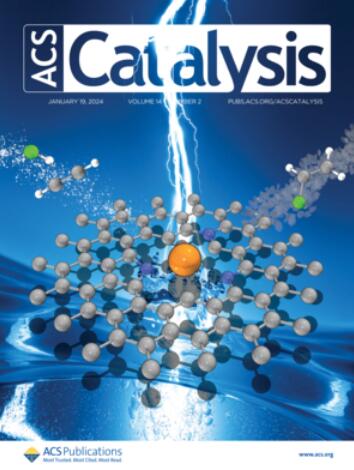Improved Activity and Durability of Carbon-Capped Pd and PdNi Catalysts─From Model Active Layers to Anion-Exchange Membrane Fuel Cell Electrodes
IF 11.3
1区 化学
Q1 CHEMISTRY, PHYSICAL
引用次数: 0
Abstract
Carbon-supported and carbon-capped Pd (Pd@C/C) and PdNi (PdNi@C/C) nanoparticles were synthesized and characterized physicochemically. The presence of the carbon cap minimizes surface metal oxides after synthesis, while the metal loading, size, and composition of the nanoparticles on the carbon support can be tuned. After mild electrochemical activation, these catalysts outperform commercial (non-carbon-capped) Pd/C and PdNi/C catalysts for the alkaline hydrogen oxidation reaction (HOR): the beneficial effect of Ni alloying and of the carbon cap makes PdNi@C/C the best catalyst because it exhibits a metal–metal oxide surface compatible with fast HOR, both initially and during accelerated stress tests performed using rotating disk electrodes. The carbon cap prevents significant oxidation/passivation and leaching of the metals, thereby enhancing the materials’ stability and minimizing their passivation. The Pd@C/C and PdNi@C/C catalysts were upscaled and integrated in low-loaded anodes in Pt-free anion-exchange membrane fuel cells designed to be anode-limiting. The Pd@C/C and PdNi@C/C anodes surpassed Pd/C and PdNi/C anodes, in terms of both activity and stability, thereby confirming the results obtained in liquid alkaline electrolytes, with PdNi@C/C being the winner HOR catalyst. Carbon capping is, therefore, a successful strategy to obtain active and stable HOR catalysts.

碳盖Pd和PdNi催化剂活性和耐久性的提高──从模型活性层到阴离子交换膜燃料电池电极
合成了碳负载和碳包覆的Pd (Pd@C/C)和PdNi (PdNi@C/C)纳米粒子,并对其进行了物理化学表征。碳帽的存在使合成后的表面金属氧化物最小化,而碳载体上纳米颗粒的金属负载、尺寸和组成可以调整。在轻度电化学活化后,这些催化剂在碱性氢氧化反应(HOR)中的表现优于商业(非碳帽)Pd/C和PdNi/C催化剂:Ni合金化和碳帽的有利作用使PdNi@C/C成为最佳催化剂,因为它在初始和使用旋转圆盘电极进行的加速应力测试中都表现出与快速HOR相容的金属-金属氧化物表面。碳帽可防止金属的显著氧化/钝化和浸出,从而提高材料的稳定性并最大限度地减少其钝化。将Pd@C/C和PdNi@C/C催化剂升级并集成到无pt阴离子交换膜燃料电池的低负荷阳极中,以达到阳极限制的目的。Pd@C/C和PdNi@C/C阳极的活性和稳定性都超过了Pd/C和PdNi/C阳极,从而证实了在液体碱性电解质中得到的结果,PdNi@C/C是获胜的HOR催化剂。因此,碳封顶是获得活性和稳定的HOR催化剂的一种成功策略。
本文章由计算机程序翻译,如有差异,请以英文原文为准。
求助全文
约1分钟内获得全文
求助全文
来源期刊

ACS Catalysis
CHEMISTRY, PHYSICAL-
CiteScore
20.80
自引率
6.20%
发文量
1253
审稿时长
1.5 months
期刊介绍:
ACS Catalysis is an esteemed journal that publishes original research in the fields of heterogeneous catalysis, molecular catalysis, and biocatalysis. It offers broad coverage across diverse areas such as life sciences, organometallics and synthesis, photochemistry and electrochemistry, drug discovery and synthesis, materials science, environmental protection, polymer discovery and synthesis, and energy and fuels.
The scope of the journal is to showcase innovative work in various aspects of catalysis. This includes new reactions and novel synthetic approaches utilizing known catalysts, the discovery or modification of new catalysts, elucidation of catalytic mechanisms through cutting-edge investigations, practical enhancements of existing processes, as well as conceptual advances in the field. Contributions to ACS Catalysis can encompass both experimental and theoretical research focused on catalytic molecules, macromolecules, and materials that exhibit catalytic turnover.
 求助内容:
求助内容: 应助结果提醒方式:
应助结果提醒方式:


